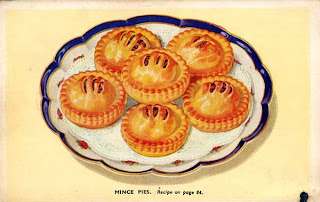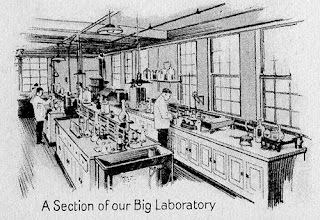I didn't make any New Year resolutions, but I have promised myself that from now on I will religiously back up my computer on a regular basis. It was done somewhat haphazardly in the past and I've been extremely fortunate in that I've never lost anything important. It was a close call this time and I had to pay someone to retrieve the information I thought was lost.
The computer itself was pretty much toast, however, and I had to get another one. My computer collection is beginning to rival my cookbook collection in that there are too many. I tend to save the old ones because there's always some program or peripheral that I use sometimes that won't work on the newer ones. I've been especially slow to warm up to Windows 7, hence my foot dragging in getting my printers and scanners and assorted software all straight on the one I'm using now. At least my scanner is finally hooked up and I've found some new photo editing software that I'm satisfied with.
Hopefully I'll be posting again on a regular basis. I just like to do my work, not have to mess with all of the devices and programs that help me get it done.
For almost twenty years, I've attended a local auction that brings over containers of English antiques. I'm not sure how the auctioneer chooses what's in the containers, but it's usually furniture and smalls and not much paper. Occasionally there are books, but they're always musty and not in the best of condition. Finally, after all these years, there was a small batch of advertising cookbooks from England, and to top it off, they were in fairly decent condition. They didn't even smell like they had crossed the ocean stored away in a wet, moldy trunk!
I've enjoyed looking through them because although they're the same as the ones from the U.S., they're for different product brands and, of course, some of the recipes are quite different from the recipes for the things we eat here.
Be-Ro Home Recipes (Thomas Bell & Son Ltd., 60 pp.) is one of the older booklets in the lot. I've noticed that not very many of them have the publishing dates stated in the publishing information. That leaves it to guesswork.

Be-Ro is a brand of self-raising flour. The booklet also shows some of their other products such as Be-Ro Snow Cake mixture and Be-Ro Ground Rice. I'm not sure exactly what a Snow Cake is and haven't the time to look it up right now. Perhaps one day....
You can see an earlier edition of this booklet in its entirety at the Duke University Digital Collection of cookbooks. The recipes below are for scones.

This page shows an illustration of the one-pound, three-pound and six-pound paper packages. The Be-Roy website shows illustrations of some of the older editions of their cookbooks and also tells how you can order a copy of the newest (40th) edition. Historically, the Be-Ro brand of flour appears to be as popular as our Gold Medal and Pillsbury flours.

Tough Guy Grub (Atora, 60 pp.) is a relatively modern recipe booklet that's promoting Hugon's Atora Shredded Beef Suet. No publishing date on this one either. Suet is the raw, hard fat found near the loins and kidneys of beef and mutton. It's traditionally used in British puddings and pastries.

This booklet has a plethora of recipes for dumplings, both cold and hot puddings (baked and steamed) as well as recipes for other savory dishes and sauces. In the U.S. puddings are primarily dairy-based desserts, while in the United Kingdom, the term also includes savory dishes.

The Atora website has an interesting history of their company as well as an offer to get a new recipe booklet.

Trex Cookery Book for Better Cooking (J. Bibby & Sons, Ltd., not dated, 86 pp.) is a recipe book for a popular brand of vegetable shortening used in the U.K. This old cookbook has the lovely color illustrations like the ones found in the 1920s and 1930s cookbooks here in the U.S.


According to the Trex website, this product was introduced in the 1930s as a "dairy-free alternative for baking." 
The recipes in this booklet tell how to bake cakes, pastries and how to use Trex for frying. At the time of publication it was a relatively new product and emphasized how much better was is to use instead of margarine, lard or butter. The two recipes below are for Cornish Pasties and Fish Cakes.

The Best of Scott's Cookery (R.H.M. Foods Ltd., not dated, 16 pp.) is a fairly modern recipe book for the Scott's brand of Porage Oats. The booklet contains recipes for soups and broths, main courses, puddings, cakes and breads. Not all of the recipes contain the oats.

Some of the recipe names are quite unusual sounding to the American ear: Cock-a-Leekie, Potted Hough, Haggis, Bashed Neeps, Rumbledethumps, Forfar Bridies, Minced Collops, Stovies, Cloutie Dumpling, Chocolate Cabers, Selkirk Bannock, Broonie. Others have names that are more similar to the ones we are used to hearing: Scotch Bun, Oatmeal Soup, Highland Chicken, Oatmeal Stuffing, Potato Scones.
The recipes below are for Angus Haddock and Tattie Supper, Oatmeal Stuffing and Stovies:

You can find more recipes for Porage Oats on the Scott's website.
The last cookbook today, The Best of British Bacon Recipes (British Bacon, 1979, 96 pp.) by Mary Norwak, is a traditional paperback book, printed with black and white line drawings as the illustrations. I believe the Harris that is referred to on the cover is but one of the different brands of bacon available in the U.K.

The bacon in the U.K. is a bit different than that we eat here in the U.S. and I think this post explains it rather well (plus, I like his illustrations). There are several pages in this cookbook that tell about the different kinds of British bacon.

I'm a big fan of bacon sandwiches, but the thought of partaking in this recipe for Fried Bacon Sandwiches that's also dipped in egg and breadcrumbs and then fried would make me feel guiltier than I already do for eating them in the first place.

I've had to restrain my self from thinking about ordering the newest cookbooks that were mentioned on the websites of the first couple of booklets. All I need to do is start amassing large numbers of cookbooks from another country. I still have enough of the American variety to last me a lifetime!





















